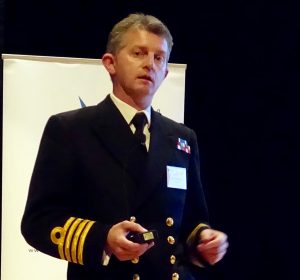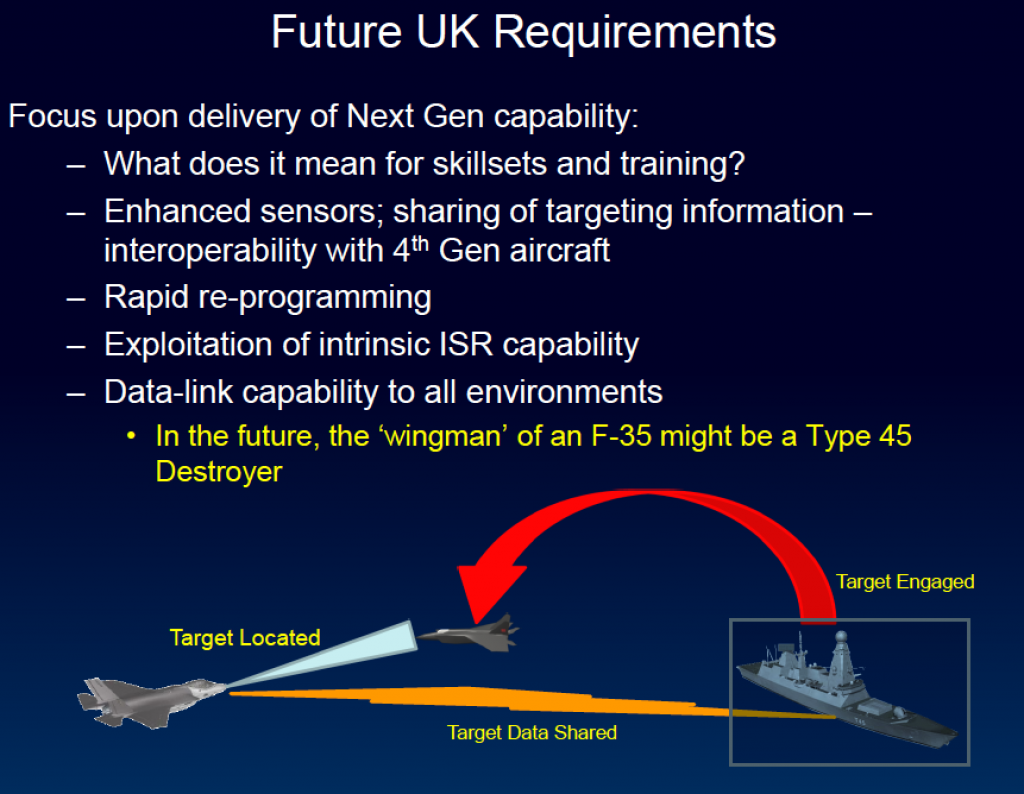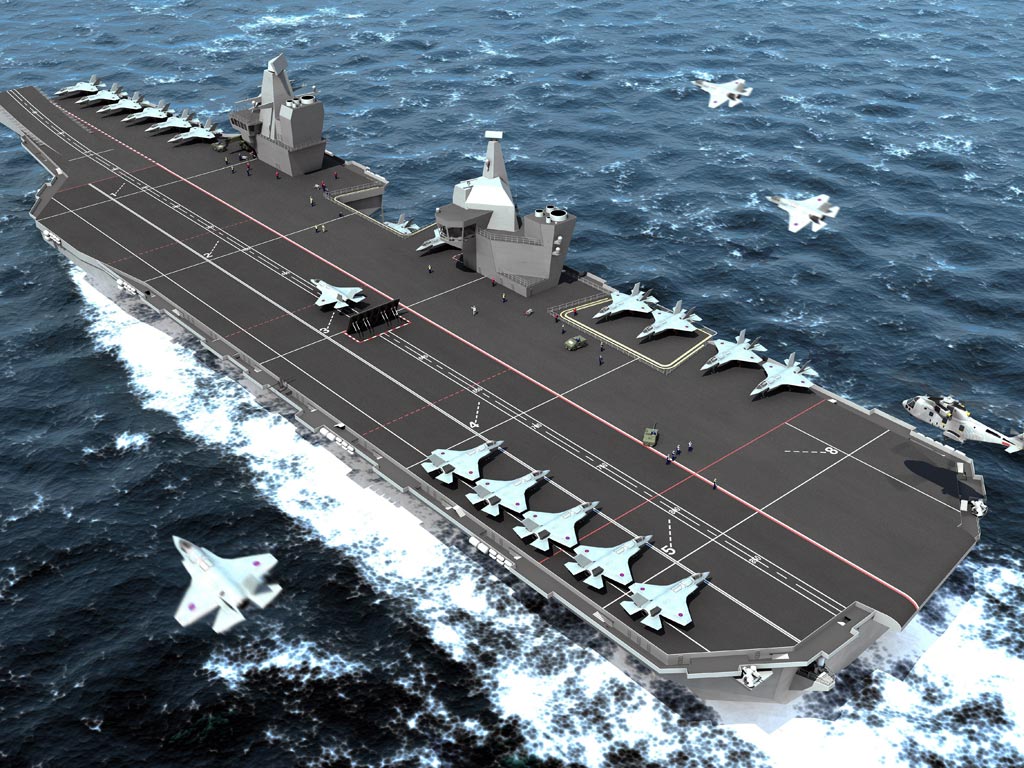2016-09-06 By Robbin Laird
Recently, the Williams Foundation held their latest seminar on 5th generation enabled combat. This one focused on new approaches to air-sea integration, and featured two key foreign military perspectives.
The first was provided by Rear Admiral Manazir, who currently serves as the deputy chief of naval operations for warfare systems (OPNAV N9) on the staff of the chief of naval operations. In this capacity, he is responsible for the integration of manpower, training, sustainment, modernization and procurement of the Navy’s warfare systems.
His presentation focused on the strategic context for the U.S. and allied maritime forces and shaping a convergent way ahead. How can the allies shape convergent capabilities to ensure that the global commons remain open, and not controlled by powers seeking to enforce their will against the allied powers?
Rear Admiral Manazir highlighted the kill web approach as a way to shape more effective integration of force and convergence of efforts.
The kill chain is a linear concept, which is about connecting assets to deliver fire power; the kill web is about distributed operations and the ability of force packages or task forces to deliver force dominance in an area of interest.
It is about building in integration from the ground up so that forces can work seamlessly together through multiple networks, rather than relying on a single point of failure large network.
https://sldinfo.com/rear-admiral-manazir-in-australia-allied-convergence-on-the-kill-web/
The second major presentation by a foreign military leader was by Captain Nick Walker of the Royal Navy, who is on the Naval Staff. Earlier, we interviewed Captain Walker as part of a RN and RAF team discussing the carrier and strike aviation during an interview conducted at Whitehall in the first quarter of 2014.
He was then Commander Nick Walker and serving as the Chief of Staff Carrier Strike in the Carrier Strike and Aviation Division within Navy Command Headquarters in Portsmouth.
https://sldinfo.com/the-new-uk-aircraft-carrier-reshaping-the-royal-navy-and-the-royal-air-force/

During that interview, Captain Walker underscored a key point about the new capability for the national decision makers:
Question: How does this evolving capability affect a possible rethink about the way ahead for the forces?
Walker: This evolving capability will give the decision maker a lot of flexible tools to respond or prepare for crises.
The Maritime Task Force can be well integrated with land based air but does not need a lot of forward ground presence to generate combat effects.
This can give decision makers significant flexibility with regard to a crisis or to have the ability to move to crises rather than having to generate force build up in a particular place in order to intervene.
Captain Walker certainly picked up on that theme and wove the carrier discussion within a broader emphasis on how it both triggered and reflected the transformation process for the UK power projection forces.
He underscored that both the F-35 and the carrier are being brought into service together, and together they are key definers of the new power projection approach for an information age.
The carrier is being introduced from the ground up as a joint asset; not simply a maritime asset.
“The carrier strike journey is driving significant cultural change in the forces as well.”
He started by focusing on the core point that the carrier is coming into service as part of the overall transformation of UK power projection capabilities. Indeed, the CEPP or Carrier Enabled Power Projection statement of intent highlights the way ahead:
“An integrated and sustainable joint capability, interoperable with NATO, that enables the projection of UK Carrier Strike and Littoral Manoeuvre power as well as delivering humanitarian assistance and defence diplomacy, enabling joint effect across the maritime, land and air environments at a time and place of political choosing.”
He noted that the role of Special Forces has been highlighted since this original statement and will be folded into the revised statement of intent with regard to the role of the carrier within the UK forces.
CEPP has been maintained within the Ministry of Defence. This is in distinction to most other capabilities, which have been given to the front line commands. This allows joint forces command and the services to focus on CEPP as a joint capability.
The deck of the Queen Elizabeth carrier is 85% of the size (i.e. area) of a Nimitz class carrier; which can carry up to 36 F-35Bs along with a Merlin Crowsnests and a Merlin Mk2 ASW helo. Alternatively, the ship can be used in the projection of land forces from the sea in terms of Marines and helo insertion capabilities as well.
But it is the carrier strike focus which is definitional for the new carrier.
The ship has been designed from the ground up to support F-35B, in terms of weapons, C2, and ISR integration.
“We have also built from the ground up interoperability, and have worked closely with the USN and USMC with regard to this capability. And we are working on a broader approach to NATO interoperability as well.”
He provided an overview of the timing of the build out of the ship and the process of marrying it with the movement of the UK F-35Bs being prepared and trained in the United States to its permanent location in the UK at RAF Marham.
The initial carrier IOC is projected to be December 2020 with the fully integrated F-35 and carrier having full operational capability by 2025.
Much like the leadership of the Royal Australian Navy focused on in their presentations at the seminar, Walker emphasized new approaches to task forces as key part of their transformation approach.
Clearly, the UK is looking at the evolving impact of introducing carrier strike upon the overall change in the RAF and Royal Navy as well. And a key aspect of this transformation is working the evolving integration of fifth gen upon legacy capabilities.
Captain Walker highlighted the shift from a legacy mindset, which focused on thinking of maritime versus air environments to an integrated information dominance environment.
“A key cultural change is that we are looking at air and maritime as an integrated domain; and we are looking at the interaction among the environmental seams of our forces driven by a kill web approach and capability.”
A clear challenge is reworking C2.
“We need to shape a more mission order vice a directive Air Tasking Order approach to the use of an integrated air-maritime force.”

Putting the new carriers in play completely integrated with the F-35 will provide the foundation for shaping the way ahead for the UK power projection forces.
Put bluntly, shaping the way ahead will be defined by the operational experiences entailed in operating and deploying the new carrier strike force and leveraging that capability will be crucial in thinking through future procurement decisions as well.
“We are focused on being more platform agnostic; and ironically, the F-35 can be looked at as a new platform an keep in the old platform-centric approach but we are looking at it as lever of change for next generation thinking and capabilities.
“We are taking the kill web concept very seriously, and examining how best to shape the desired outcome from nodes in the operational force, rather than focusing on specialized platforms.
“How do we generate operational tasks to be delivered from the integrated force?”
“How do we bring the Typhoon which is a key air asset into the kill web?
“Rapid reprogramming of platforms is a crucial way ahead for sure.
“The ability to exploit the intrinsic ISR capability of the force, rather than simply relying on specialized ISR platforms is a key way ahead as well.
“The ability to deliver effect throughout the force with data-link capabilities such as in the future the wingman of an F-35 could well be the Type 45 destroyer”
In short, Captain Walker saw significant commonality in terms of the Australian rethink about the way ahead for their navy and how the UK was thinking about the transformation of its power projection capabilities.


